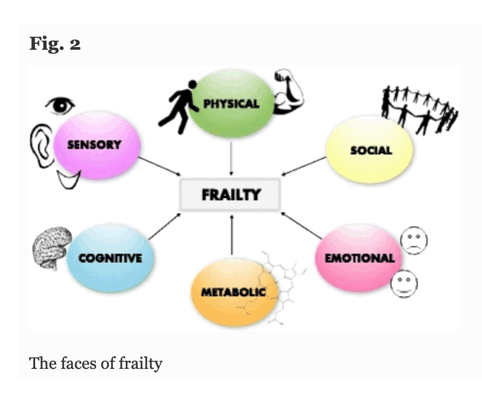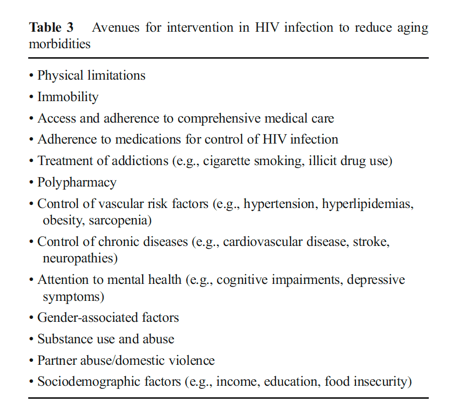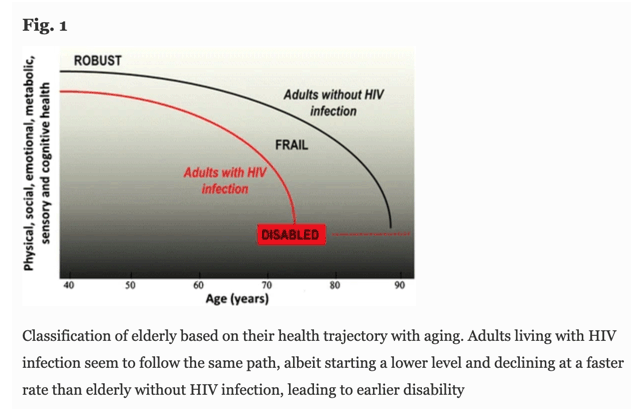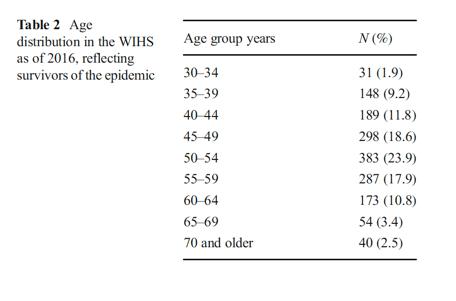| |
Faces of Frailty [women] in Aging with HIV Infection
|
| |
| |
Download the PDF here
Current HIV/AIDS Reports 2017 Marion Thurn, Deborah Gustafson
In this review, we explore aging in HIV infection from the standpoint of frailty, an aging syndrome, and through the specific lens of HIV infection among women.
Frailty and Death
We are also predicting death by frailty indices within the WIHS. Why would multi-dimensional frailty indices be associated with mortality in adults with HIV infection? Throughout adult life, HIV infection is synergistic with adverse aging influences on the immune, vascular, reproductive, and central nervous system, thereby intensifying the aging process [25, 26]. As aforementioned, aging with HIV infection is associated with geriatric morbidities or syndromes, including frailty [27]; however, these aging morbidities often occur earlier among those with HIV infection compared to uninfected individuals [4, 5, 28]. The question is whether HIV infection leads to more severe aging phenotypes, or accelerates their onset leading to earlier age of death, or is a cumulative marker of multiple morbidities [29].

----------------------------------------------
HIV+ Women Have Higher Burden of Comorbidities vs HIV- Women / Accelerated-Earlier by 10 Years
Previous general population studies suggest that frailty is associated with older age, female sex, minority race/
ethnicity, lower socioeconomic status, geographic location, comorbidities, poor nutrition, smoking, and possibly alcohol consumption [1,4,11- 14].
https://www.natap.org/2019/HIV/Prevalence_and_1_year_incidence_of_frailty_among.21.pdf
This study reveals that BHWH aged 50 and above are a vulnerable population greatly affected by health disparities and psychosocial issues related to living with HIV infection. Higher levels of avoidant coping, depressive symptoms, and negative self-perception of health, as well as decreased social support, were significant predictors of psychosocial illness impact among our sample. Findings from this study have important implications for health policymakers and clinicians because they support the need to improve the psychosocial wellness of women living with HIV infection, specifically for BHWH aged 50 and above.
women reported worse quality of life,
physical function, exhaustion; increased fracture rate for HIV+ women - menopause appears to contribute to worse aging, cognitive function; fracture risk rises farther as women transition through the menopause, "particularly if they are already frail. - AGE: Physical function worse in older women than men with HIV, despite better CD4 recovery 55% of men & women with poor physical functioning, exhaustion, pain
Frailty is associated with mortality and incident comorbidity among middle-aged HIV-positive and HIV-negative participants.
CD4 nadir, a previously reported risk factor for mortality,[24] was associated with a 50% reduced survival per 100 cell decrease. Older Men HIV+ Over 60 in MACS: 50% had a fall, double seen in HIV-neg older men which is 20%. Frail participants tended to more frequently be HIV-positive, older, a current smoker, and to have more pre-existing comorbidities. Mortality rates/1,000 PYFU were notably higher among those who were frail 25.7 compared to those who were either prefrail (7.2) or robust (2.3), p<0.001for both comparisons).
Frailty Predicts Fractures Among HIV-infected and Uninfected Women: Results from the Women's Interagency HIV Study
In analyses of frailty components, exhaustion (aHR 1.60), unintentional weight loss (aHR 1.44), and reduced grip strength (aHR 1.35), were independently associated with time to first fracture in all women, as well as among HIV-infected women only [exhaustion (aHR 1.57), unintentional weight loss (aHR 1.44), and reduced grip strength (aHR 1.36)].
------------------------
In this review, we explore aging in HIV infection from the standpoint of frailty, an aging syndrome, and through the specific lens of HIV infection among women.
With the increase in numbers of chronically HIV+ aging adults, it may be important to develop new indices to evaluate frailty that include components related to the infection. With the growing population of aging and HIV+ women in the world, a frailty index for HIV+ women would be an invaluable asset, as well as for the development of more precise and effective measures to prevent further disabilities.

According to PubMed, frailty was first reported in 1956, in an article entitled "Frailty of old age and bacterial allergy" [9]. Subsequent to initial, isolated reports, frailty as a health outcome became consistently reported beginning in the late 1980s. Since then, varying definitions of frailty and essential components of frailty have been put forward. For example, frailty has been defined as a clinical syndrome [10]-a composite of physical symptoms, referred to as the frailty phenotype (FP) [11]-and the accumulation of deficits [12, 13]. Underlying all definitions of frailty is the concept that to prevent the sequelae, which includes disability followed by death; the reversible frail state must be identified using a screening tool (see Table 1 for list of published frailty indices). Most geriatric indices and scales used in clinical practice to assess health in aging adults do not assess frailty in its entirety but can be used to assess selected components of the frail state.
The Fried Frailty Index (FFI), a physical frailty index, was validated in the Cardiovascular Health Study in 1998 and by Kiely in 2009. The FFI is a useful construct to predict poor quality of life, cognitive impairment, dementia, and death [14]. The FFI is composed of five components: weakness, slowness, exhaustion, low physical activity, and unintended weight loss [11]. Fulfilling at least three of the five components denotes frailty. However, the faces of frailty include emotional, social, cognitive, metabolic, and sensory frailty existing alongside physical frailty (see Fig. 2); thus, the FFI has been associated with other health indices such as the Center for Epidemiologic Studies Depression scale (CES-D scale) [5, 15, 16].
In traditional studies of aging, elderly people are classified into one of three categories: robust, frail, and disabled [7] (see Fig. 1). To be robust is to be without frailty or disability. Frailty is a vulnerability state characterized by impairments and limitations that might lead to disabilities. It represents the vulnerability that increases risk of negative health outcomes, loss of independence, and of mortality [8]. In contrast, being disabled means there are important deficits that restrict a woman from performing daily activities on her own. Whereas frailty seems to be reversible and sensitive to prevention, disability tends to be permanent and may lead to hospitalization, institutionalization, and death. This classification is essential to evaluate health in aging populations and to provide appropriate health care. It is crucial to detect frail adults before they become disabled and to apply active prevention measures of this irreversible state.

Studies show that adults with HIV infection experience a prevalence of frailty equivalent to and even greater than that observed in elderly [16, 20, 21]. The reason for this early manifestation of frailty may be a consequence of the HIV infection itself, suboptimal medication and control of infection early on, comorbid diseases (infectious or non-infectious) [21, 22] and/or other lifestyle habits, such as smoking and substance use, which are more common among those with HIV infection [23]. Physical frailty may be due to the HIV infection, itself. With a dropping CD4 cell count, the immune system is insufficient to protect against both infectious and chronic diseases such as cancer, cardiac diseases, and diabetes. Moreover, HIV infection is accompanied by numerous symptoms that weaken the body, including pain, weight loss, and fatigue or weakness [24]. Physical deterioration leads to vulnerability to diverse pathologies, which can lead to premature frailty among HIV-infected.
To address our question, we engaged WIHS frailty measures collected among 2028 HIV+ (n = 1449) and at risk HIV- (n = 579) WIHS women, during midlife (average age 39 years). At midlife, we operationalized the FFI similarly to the Multicenter AIDS Cohort Study (MACS), which is composed of HIV+ and HIV- men [15]. The WIHS Core battery provided FFI, HIV status, and constellations of variables representing demographic/health behaviors and aging-related chronic diseases. With an age range of 50-64 years, MACS observed 12% frailty prevalence among HIV+ and 9% among HIV- men [20]. In contrast, using similar criteria in the WIHS, the overall frailty prevalence was 15% (HIV+, 17%; HIV-, 10%) among women at midlife. A stepwise multivariable model suggested that HIV infection with CD4 count <200; age >40 years; current or former smoking; income ≤$12,000; moderate vs low FIB-4 levels; and moderate vs high eGFR were positively associated with FFI. Low or moderate drinking was protective. Typical aging-related co-morbidities such as obesity, type 2 diabetes, cardiovascular disease, and hypertension, as well as recreational drug use and self-reported or historically measured co-infections were not significantly associated with frailty in the final multivariate model. These results show that frailty is a multidimensional aging phenotype observed even in midlife among women with HIV infection; suggest that the frailty constellation may change with age; and show that prevalence of frailty in HIV-infected WIHS women exceeds that for usual elderly populations.
Ideas for Going Forward
This overview of frailty among participants in the WIHS highlights the need for geriatricians and gerontologists to interact with younger "at risk" populations and assist in the formulation of best recommendations for frailty interventions to prevent early aging, excess morbidities, and early death. In terms of preventing frailty, implementation of prevention measures should be adapted to the patient's health, needs, and motivation. Family and social networks should be assessed as well to determine support needs.

|
|
| |
| |
|
|
|